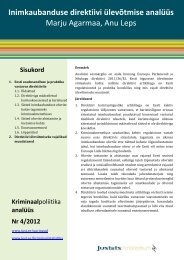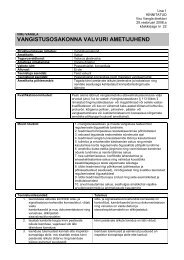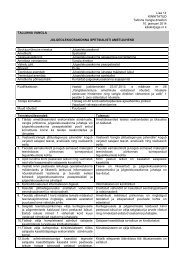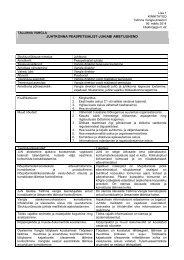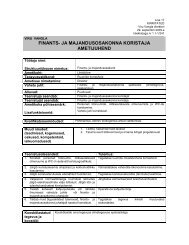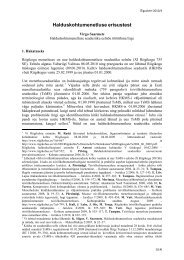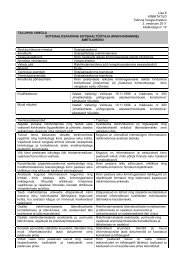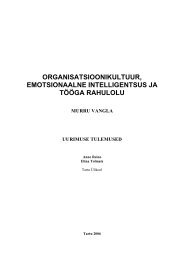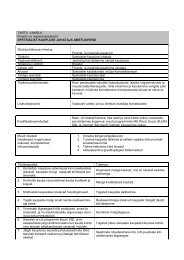11. Retsidiivsus Eestis - Justiitsministeerium
11. Retsidiivsus Eestis - Justiitsministeerium
11. Retsidiivsus Eestis - Justiitsministeerium
You also want an ePaper? Increase the reach of your titles
YUMPU automatically turns print PDFs into web optimized ePapers that Google loves.
RETSIDIIVSUS EESTIS 2010<br />
RETSIDIIVSUS EESTIS 2010<br />
After release, people who were engaged in activities in prison had clearly a<br />
smaller recidivism risk in comparison with people not engaged in activities<br />
both within one year and two years after release. At the same time, it is not<br />
possible to say what has been the role of this engagement in activities67, as<br />
probably there were relatively more people among the ones engaged in activities<br />
who were interested in purposeful activity and had a low recidivism risk.<br />
From people released in 2004-2007, nearly one third of people engaged in<br />
activities and nearly one half of people not engaged in activities committed a<br />
new criminal offence within one year after release.<br />
Within two years after release, a new criminal offence was committed on<br />
the average by 50% of people engaged in activities in prison and nearly by 60%<br />
of people not engaged in activities.<br />
5.8. Re-imprisonment of criminal offenders<br />
Re-imprisonment of a person released from prison may be related to an arrest<br />
or the imposition of a new actual prison sentence. In most cases this is related<br />
to a new criminal offence committed after release from prison, however, a<br />
reason to this may also be some pre-imprisonment criminal offence which was<br />
discovered later or the investigation of which was terminated after the release<br />
of the person from prison.<br />
In case of people released in 2004–2007, it is not possible to exactly compare<br />
the proportion of re-imprisoned people by years due to inaccuracies in the<br />
reporting of repeated imprisonment. From the people released in 2007 about<br />
one fourth was re-imprisoned within one year due to arrest, enforcement of<br />
conditional prison sentence or a new prison sentence. Approximately for two<br />
thirds of cases, the re-imprisonment was related to arresting the person.<br />
It was noted above that 40% of these criminal offenders committed a new<br />
criminal offence within one year, however, it has to be taken into consideration<br />
that these numbers are not mutually comparable; for example, the reason<br />
of re-imprisonment could have been not only a criminal offence committed<br />
after release from prison, but also some other violation of regime, or a prison<br />
sentence imposed in a criminal offence which preceded the imprisonment and<br />
has reached the court judgement only now.<br />
67 The database does not enable to simultaneously control the influence of other possible factors in order to compare<br />
the engaged and not engaged groups of people which are similar by other characteristics.<br />
ALLIKAD/REFERENCES<br />
Ahven, A. (2009). Üldkasuliku töö kohaldamine ning mõju retsidiivsusele.<br />
<strong>Justiitsministeerium</strong>.<br />
http://www.just.ee/orb.aw/class=file/action=preview/id=47520/%DCldkasulik<br />
u+t%F6%F6+kohaldamine+ning+m%F5ju+retsidiivsusele.pdf (27.01.2010)<br />
Ahven, A. ja Jakobson, J. (2009). Vangistus, väljaandes Kuritegevus <strong>Eestis</strong> 2008,<br />
Tallinn: <strong>Justiitsministeerium</strong>.<br />
Ahven, A. ja Salla, J. (2009). Varavastane kuritegevus, väljaandes Kuritegevus<br />
<strong>Eestis</strong> 2008, Tallinn: <strong>Justiitsministeerium</strong>.<br />
Aos, S., Miller, M. & Drake, E. (2006). Evidence-Based Adult Corrections<br />
Programs: What Works and What Does Not. Olympia: Washington State<br />
Institute for Public Policy.<br />
http://www.wsipp.wa.gov/rptfiles/06-01-1201.pdf (27.01.2010)<br />
Cann, J., Falshaw, L., Nugent, F. & Friendship, C. (2003). Understanding What<br />
Works: accredited cognitive skills programmes for adult men and young offenders.<br />
Home Office. London. Findings 226.<br />
http://www.homeoffice.gov.uk/rds/pdfs2/r226.pdf (27.01.2010)<br />
Chavez, R. & Dawe, S. (2007) International research and trends in education and<br />
training provision in correctional settings. Väljaandes: Dawe, S. (ed.) National<br />
Centre for Vocational Education Research. Australian Government, lk 16–26.<br />
http://www.ncver.edu.au/publications/1789.html (27.01.2010)<br />
Colorado Commission on Criminal and Juvenile Justice 2008 Annual Report<br />
(2008). Denver.<br />
http://cdpsweb.state.co.us/cccjj/PDF/2008%20Recommendations/12-10-08%20<br />
recommendations%20and%20discussion.pdf (28.01.2010)<br />
Comprehensive Recidivism Study (2002). Massachusetts Sentencing Commission.<br />
http://www.mass.gov/courts/admin/sentcomm/recrep060102.pdf (27.01.2010)<br />
Criminal Sanction and Recidivism (2009). Max Planck Institute for Foreign<br />
and International Criminal Law.<br />
http://www.iuscrim.mpg.de/ww/en/pub/forschung/forschungsarbeit/kriminologie/legalbewaehrung2.htm<br />
(27.01.2010).<br />
Drabsch, Talina (2006). Reducing the Risk of Recidivism. NSW Parliamentary<br />
Library Research Service. Briefing Paper No 15/06.<br />
http://www.parliament.nsw.gov.au/prod/parlment/publications.nsf/key/<br />
ReducingtheRiskofRecidivism (27.01.2010)<br />
212<br />
213



